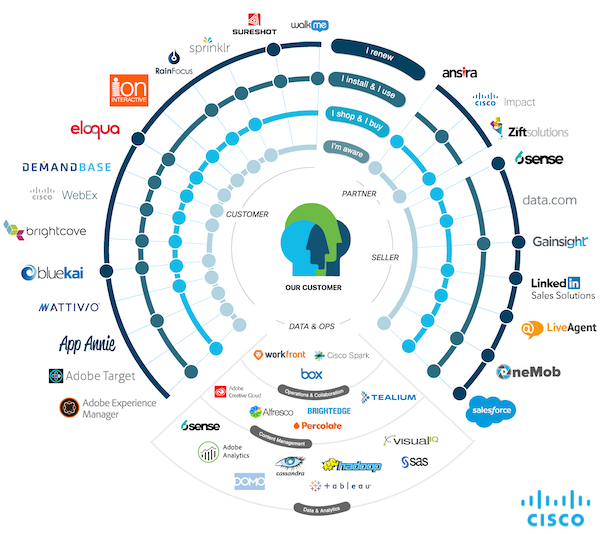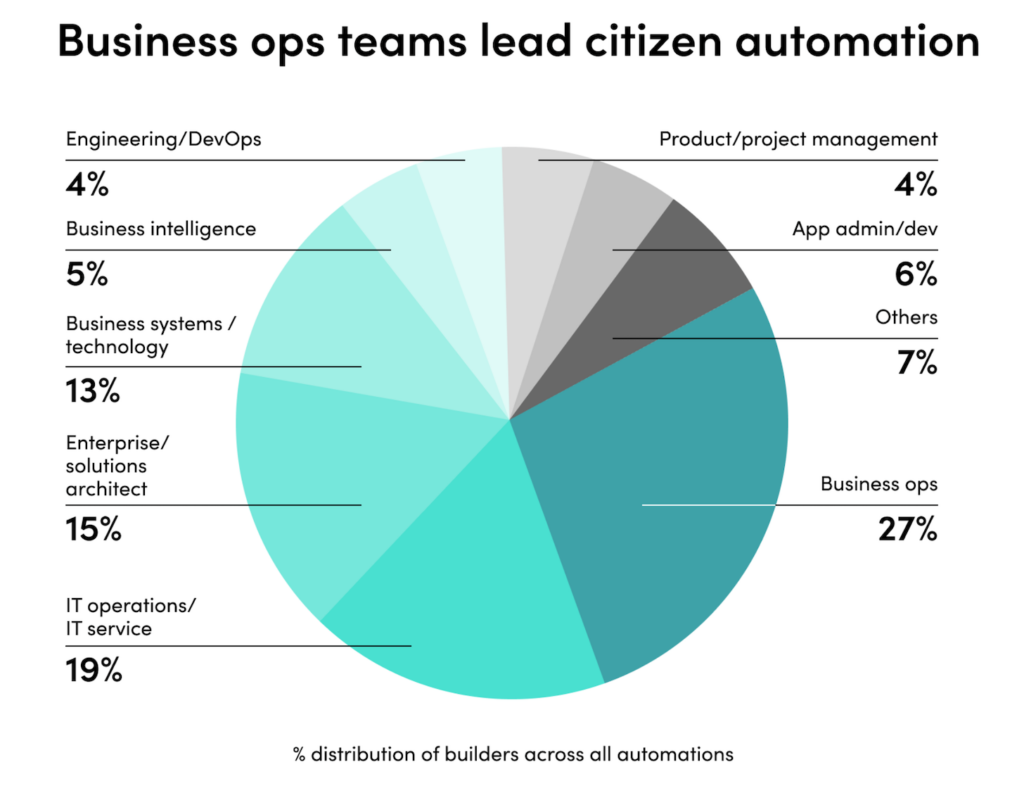The MarTech conference in San Francisco is less than two weeks away, and I’m really looking forward to kicking it off with the Stackies & Hackies awards reception on the evening of May 9. We received 57 marketing stack entries into the Stackies this year, plus 21 essays in the Hackies — so we’ll be making a donation of ((57+21)*$100) = $7,800 to Girls Who Code.
We’ll be releasing the full deck of all 57 marketing stacks after the awards ceremony, but I can’t resist sharing this stack from Cisco in advance. I’m immensely grateful for every company who contributes their stack diagram to the martech community, but I especially appreciate major brands like Cisco offering us a glimpse into their marketing technology operations.
This is a fantastic example of an elegantly organized, best-of-breed marketing stack — a master class in real-world marketing technology management condensed into a single slide:
- It features 39 different marketing technology solutions, including components from three of the major “marketing clouds” — Adobe, Oracle, and Salesforce — and dozens of leading specialist solutions for account-based marketing, social media marketing, content marketing, channel partner marketing, interactive content, mobile marketing, predictive analytics, and more. It also features, of course, Cisco’s own marketing technologies such as WebEx, Impact, and Spark.
- It’s fascinating to contrast a real-world heterogeneous stack diagram like this with the hypothetical homogeneous stack diagrams promoted by the major marketing clouds. Rather than trying to downplay this vibrant ecosystem, I really believe the major marketing clouds would be far better off leaning into the open platform opportunity that stacks like this represent. Seriously, if you examine all the technologies in Cisco’s stack, there’s not a single-vendor “marketing cloud” that comes close to offering all of these capabilities.
- It’s customer-centric with the customer literally at the center of their diagram. Four concentric circles emanating from that center define four stages of their buyer’s journey: (1) I’m aware, (2) I shop & buy, (3) I install & I use, and (4) I renew. Each martech solution is identified by the stages of that journey in which it operates — some focused on one specific stage, others providing continuity across all four as “systems of record.”
- The circles are divided into four segments, (1) customer, (2) partner, (3) seller, and (4) data & ops. The first three illuminate how different marketing technologies support direct and indirect engagements with customers. This is a great view of a stack for a company that employs both direct and channel-based sales. The last segment is focused on internal marketing operations, including collaboration services, content management, and data and analytics.
Although this stack diagram doesn’t explicitly show it, I’m going to infer that these different components are pretty well integrated. That inference is partly from the fact that each of these product vendors publicly promote their integrations with each other, and partly from the fact that from this diagram you can tell that Cisco has obviously thought through the operation of their stack very carefully. One can also infer from the inclusion of products like Cassandra, Hadoop, and Tableau — probably to enable a data science team in marketing — that they’re savvy about leveraging APIs to pass data between these systems on their own terms.
While such integration work was previously considered a downside to best-of-breed stacks, I think the fluency of orchestrating across marketing, sales, and custom internal systems has become a real organizational asset. And although Cisco is a large company, I’m seeing this capability develop at much smaller companies too — welcome to marketing in a digital world.
Want to learn how stacks like this are created and managed? Come join us at the MarTech conference in San Francisco, May 9-11. I guarantee: it will be the most real-world view of marketing technology management that you’ll find at any event this year.
2 ways to attend MarTech
The ultimate MarTech experience: All Access Pass
Get the full MarTech experience for just $1,795, a $100 savings off on-site rates. You’ll get 3 days of networking with martech leaders and experts, more than 70 presentations and keynotes across 8 tracks, and demos and solutions from over 100 leading martech vendors. Also, you get breakfast, hot lunches, snacks all day and all of the structured and unstructured networking activities and conveniences that make attending MarTech a unique, productive and enjoyable experience. Register now.
Dive into the martech ecosystem with an Expo+ Pass
Meet more than 100 amazing martech vendors in the Expo Hall. You’ll find solutions and providers, attend full-length vendor presentations and connect with your peers at the 2 networking receptions including the Stackies awards ceremony. Buy an Expo+ pass now for just $99.




Scott,
Would love to be there, but unfortunately, San Francisco is a long way from Sydney.
While the Cisco stack is mind bending, as are several of the others that have been shared, I wonder at the extent to which we are coming to rely on the new shiny thing to take the place of market and customer intelligence that comes from the human interactions and wisdom that evolves from that intimacy.
Recognising the necessity of tech intervention to manage the scale of operations, it still leaves me worried, as even in the SME’s that are my bread and butter, where the technology stacks usually are little more than a few Excel dashboards, and low brow CRM summaries, they quickly become a crutch, given weight because they are spat out by a box, and therefore must be right.
I would love to be wrong.
It’s an important point — you never want the technology to overshadow the strategy, the customer, or the business at large. My friend Gord Hotchkiss has often said: when you’re driving the car, you want to look at the dashboard but you also want to look out the windshield and in the mirrors too. Our dashboards are pretty sophisticated these days, but we still need the human guidance to look around and decide where we’re going.
I am confident the conference is another screaming success. A great initiative you have turned into an institution in a few years.
regards
Allen
Thank you, sir. But it’s really the community that makes this all work. I’m just giddy to be a part of it.
Looks vastly overcomplicated and unsustainable, like most corporations. The maturity at present appears to be.
1. Don’t let your agencies/media own your stack.
2. Grab as many cool technologies as you can.
3. Audit what you now have and make a diagram to make it look like you know what you are doing.
4. Simplify when you know what works and what doesn’t.
5. Figure our what consumer interactions (consumer 1st strategy) actually matter and how you measure performance and growth.
Take a leaf out of Grad Conn’s (CMO) marketing tech stack at Microsoft, they are at point 4 & 5!
As a commentary on the state of martech in general or specifically at Cisco? I’m sure there are a lot of companies that are following your proposed curve of maturity. But in all fairness, I see quite a few that embrace #3, #4 and #5 these days.
I disagree on your assessment of Cisco’s stack. Knowing pretty much all of the technologies they’ve deployed myself, I don’t see a lot of overlap. Each piece seems to have a pretty clear purpose, and I think there’s a lot of synergy between them.
But admittedly, without being a part of the Cisco team, we’re just looking at this like a Rorschach test: you look and see shiny-object chaos; I look and see tight martech infrastructure. You’re right, however, that the only thing that really matters in the end is what helps customers and achieves performance and growth.
I do love the Microsoft martech stack though too, and I agree it does a good job of representing the maturity of their martech organization.
This is quite useful for comparison. Does anyone have a link to Microsoft’s stack referenced above? I couldn’t find it easily via Google search.
https://chiefmartec.com/2017/03/microsoft-shares-marketing-stack-stackies-awesome/
I love that you’re supporting cool programs like Girls Who Code ~ thank you for being such a positive influence in the tech and web community.
The Stackie Awards are always enlightening and interesting, and the ways that companies visualize their stack is particularly compelling. I think it’s important to note however that for many of these large companies like Cisco and Microsoft, this is only the stack for the division or team that decided to submit for the award. In Cisco’s case above, they are also very large Marketo customers and there are quite a few other technologies in use that do not make it to this chart.
I think it would be useful for readers to have that context and understand which business unit this represents. This article makes it appear as if these are the only 39 marketing solutions in use across all of Cisco, which is incorrect.
Good point, Aaron! Actually, I was just making a similar point in this recent post about Mary Meeker’s report of an average 91 (!!) marketing-related cloud services in use by the average enterprise:
https://chiefmartec.com/2017/06/average-enterprise-uses-91-marketing-cloud-services/